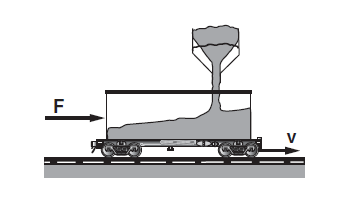Here is where I found the problem: https://physics.stackexchange.com/a/589954/330587
Sand falls from a stationary hopper onto a freight car that moves with uniform velocity 𝑣. The sand falls at a rate of 𝑑𝑚/𝑑𝑡. What force is needed to keep the freight car moving at the speed of 𝑣?

The correct solution is $F = \frac{dmv}{dt} = \frac{dm}{dt} v$.
I found a contradiction if I use the work-energy theorem to solve the problem.
$\begin{equation}W = \Delta KE = \frac{1}{2} m v^2\end{equation}$
$F = \frac{dW}{dx} = \frac{d}{dx}\left(\frac{1}{2} m v^2\right) = \frac{1}{2} v^2 \frac{dm}{dx} = \frac{1}{2} v^2 \frac{dm}{dt} / \frac{dx}{dt} = \frac{1}{2} v^2 \frac{dm}{dt} / v = \frac{1}{2} v \frac{dm}{dt}$
What is wrong with this approach? I also found on the post by Ryan that the form of the kinetic energy derivated from Newton's Second law with variable mass is consistent with the conclusion here. But does that mean the standard form of the work-energy theorem does not apply when solving problems with variable mass?
I haven't found other similar questions on the internet yet. Please correct me if I'm wrong.
